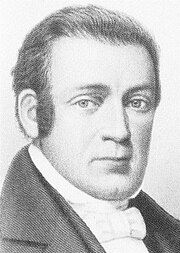Paul Moody (inventor)
Paul Moody (May 23, 1779 – July 5, 1831) was a U.S. textile machinery inventor born in Byfield, Massachusetts (Town of Newbury). He is often credited with developing and perfecting the first power loom in America, which launched the first successful integrated cotton mill at Waltham, Massachusetts in 1814, under the leadership of Francis Cabot Lowell and his associates.
Early life
Paul Moody was born May 24, 1779 at Byfield, Massachusetts, the son of Paul Moody and one of nine children.[1]
Although Moody's academic education was limited, at age sixteen he learned the weaver's craft,[1] and soon became an expert. He later went to work at a nail factory of Jacob Perkins, first in Byfield and later in Amesbury, Massachusetts when the company moved. In 1812 he worked for Kendrick and Worthen, makers of carding machinery.[2]
On July 13, 1800 (one source says September 1798[1]), he married Susan Morrill of Amesbury.[3][4] The couple went on to have three sons.[3]
Soon after his marriage, he partnered with Ezra Worthen, Thomas Boardman and Samuel Wigglesworth to form the Amesbury Wool and Cotton Manufacturing Company.[5] It was incorporated on February 16, 1813.[5]
Waltham
In 1814 he arrived at Waltham, Massachusetts to supervise the setting up of machinery for a new cotton mill under Francis Cabot Lowell and The Boston Associates.[3] Moody created the first power loom that harnessed the city's streams, canals, and rivers.[3] The patent for the loom went to Lowell and his partner.[3]
During his time in Waltham, Moody was awarded other patents. This included one in 1816 for what would eventually become the filling frame (the invited item completed in 1819).[3][4][6] He improved upon the double speeder, a device for roping cotton and got the patent on April 3, 1819.[4] On January 17, 1818, he improved upon the soapstone rollers for Horrocks' dressing machine thereby doubling its efficacy.[4]
Moody Street in downtown Waltham is named after Paul Moody.
Lowell
With the success of Waltham, The Boston Associates established an entirely new city in 1821-1825 along the banks of the Merrimack River in East Chelmsford.[3][4] The city became Lowell, named after Francis Cabott Lowell.[3] There, in 1824, Moody built Lowell Machine Works, to supply the mills with their machines.[3][4][7]
In 1824 Moody developed a system of leather belting and pulleys to power machinery, which was almost exclusively used in American mills from then on. The new mode of power transmission was more economical and required less maintenance than the shaft-and-gear system used in the British mills.[8] See: Line shaft
From 1823-5 Moody was the chief engineer for the Locks and Canals Company.[9] During that time he lived in the house now known as the Moody-Whister-Francis House (currently housing the Whistler House Museum of Art).[9]
Moody suddenly died in Lowell in 1831 after a 3-day illness.[3][4][10] He was later honored by having streets in Waltham and Lowell, Massachusetts named after him, although sections of the one in Lowell were later renamed University Avenue and Textile Avenue, as it continues into neighboring Dracut, Massachusetts.
See also
- Francis Cabot Lowell
- Boston Manufacturing Company
- Lowell, Massachusetts
- Waltham, Massachusetts
- Paul Whitin
- David Wilkinson (machinist)
References
- ^ a b c Moody, Charles C.P. (1847), Biographical sketches of the Moody family, Boston: S. G. Drake, p. 145, retrieved 2012-01-26
- ^ History of Lowell and Its People By Frederick William Coburn
- ^ a b c d e f g h i j Encyclopedia of World Biography. Detroit: Gale. 2009.
- ^ a b c d e f g Dictionary of American Biography. New York: Charles Scribner's Sons. 1936.
- ^ a b 1812 Chap. 0080. An Act To Incorporate The Amesbury Wool And Cotton Manufacturing Company (PDF). 1812. p. 153. Archived from the original (PDF) on 2016-03-04. Retrieved 2015-02-21.
- ^ Biographical dictionary of American business leaders By John N. Ingham
- ^ NPS Lowell Machine Shop
- ^ Suffolk Mills Turbine Exhibit Pamphlet
- ^ a b Marion, Paul (2014). Mill Power. New York: Rowman and Littlefield. p. 194. ISBN 978-1442236288.
- ^ Bulletin of the Essex Institute , Volumes 7-8

